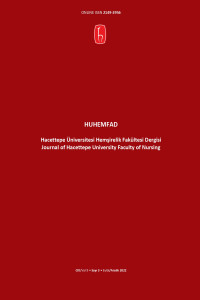Öz
Amaç: Araştırma, epilepsili çocuklarda tamamlayıcı ve integratif tedavi kullanım yaygınlığını ve kullanılan yöntemleri belirlemek amacıyla yapılmıştır.
Gereç ve Yöntem:Bu kesitsel tip araştırmaya, epilepsi tanılı çocukların ebeveynleri (294 ebeveyn) katıldı.
Bulgular: Araştırmada çocukların yaş ortalaması 7.75±3.30 olup, ebeveynlerin tamamlayıcı ve integratif tedavi kullanım sıklığı %62.9’du. En yaygın bildirilen tamamlayıcı ve integratif tedavi türü dua ve muska takma (%90) idi. Bunu sarımsak ve süt karışımı (%31.6), özel diyet (%16.6), bal (%15.0), psikolojik görüşmeler (%10.5) ve kekik suyu (%9.4) izledi. Tamamlayıcı ve integratif tedavi kullanımı ile anlamlı olarak ilişkili olan faktörler; 12 ve üzeri yaş (DOO 19.06, 95% GA 3.39-107.15), düşük sosyoekonomik durum (DOO 10.91, 95% GA 1.89-62.84), orta sosyoekonomik durum (DOO 7.05, 95% GA 1.37-36.23), ailede epilepsi öyküsü (DOO 2.15, 95% GA 1.13-4.08), yılda 1 kereden az nöbet geçirme (DOO 3.50, 95% GA 1.25-9.81) ve eşlik eden en az bir hastalık (DOO 2.54, 95% GA 1.16-5.58) olmasıdır (p<0.05).
Sonuç: Epilepsili çocuklarda tamamlayıcı ve integratif tedavi yaygın olarak kullanılmaktadır. Tedavinin etkinliği için ebeveynlerin tamamlayıcı ve integratif tedavi yöntemlerinin belirlenmesi gereklidir.
Anahtar Kelimeler
Öz
Aim: The research was conducted to determine the prevalence of complementary and integrative therapy use in children with epilepsy and the methods used.
Material and Methods: Parents (294 parents) of children diagnosed with epilepsy participated in this cross-sectional study.
Results: In the study, the mean age of the children was 7.75±3.30, and the frequency of use of complementary and integrative therapy by the parents was 62.9%. The most commonly reported complementary and integrative treatment type was prayer and wearing amulets (90.0%). This was followed by a mixture of garlic and milk (31.6%), special diet (16.6%), honey (15.0%), psychological interviews (10.5%), and thyme juice (9.4%). Factors that were significantly associated with the use of complementary and integrative therapy were age 12 and over (AOR 19.06, 95% CI 3.39-107.15), low socioeconomic status (AOR10.91, 95% CI 1.89-62.84), moderate socioeconomic status (AOR 7.05, 95% CI 1.37-36.23), family history of epilepsy (AOR 2.15, 95% CI 1.13-4.08), seizure less than once a year (AOR 3.50, 95% CI 1.25-9.81), and at least one concomitant disease (AOR 2.54, 95% CI 1.16-5.58) (p<0.05).
Conclusion: Complementary and integrative therapy are widely used in children with epilepsy. For the effectiveness of the treatment, it is necessary to determine the parents' complementary and integrative treatment methods.
Anahtar Kelimeler
Çocuklar epilepsi tamamlayıcı tedaviler Children complementary therapies epilepsy
Ayrıntılar
| Birincil Dil | Türkçe |
|---|---|
| Konular | Sağlık Kurumları Yönetimi |
| Bölüm | Araştırma Makaleleri |
| Yazarlar | |
| Yayımlanma Tarihi | 6 Ocak 2023 |
| Gönderilme Tarihi | 17 Aralık 2021 |
| Yayımlandığı Sayı | Yıl 2022 Cilt: 9 Sayı: 3 |


